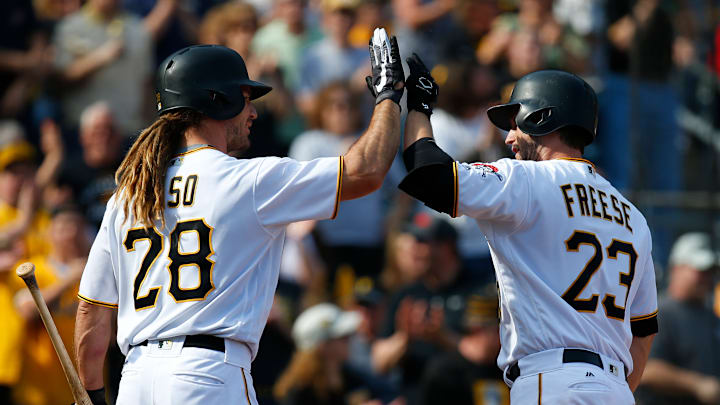The Pittsburgh Pirates are going into a critical offseason. This will be the last winter before the current collective bargaining agreement expires, which will likely end in some sort of work stoppage that delays the 2027 season. Pressure on the Pirates should be higher than ever right now, and they desperately need hitting. The Pirates cannot rely solely on internal help. They reportedly have about $30-$40 million to play with, which should be enough, especially if they go by their playbook from a decade ago. The 2015-2016 offseason was one of the Pirates’ most active winters in recent history, and the additions they made during that period should set the framework for what they should do this offseason.
Their first notable signing of the 2015-16 offseason was John Jaso. Jaso made the move from behind the plate to first base, and he did so gracefully. He turned in a .268/.353/.413 line, and added a 109 wRC+ over 432 plate appearances. Jaso only struck out 17.1% of the time, while drawing walks at a 10.1% rate. While he didn’t provide the power you’d typically see from a first baseman, with only eight home runs and a .145 isolated slugging percentage, he was an overall above-average hitter.
Right before the start of spring training, Pittsburgh signed outfielder Matt Joyce on a minor league deal. Joyce ended up as the most productive of any of the players the Pirates signed during this particular offseason, as he hit .242/.403/.463 with a .375 wOBA and 136 wRC+. Joyce had an astounding 20.1% walk rate, while going yard 13 times and posting a .221 isolated slugging percentage. He was primarily used in a fourth outfield/platoon role, with only 293 plate appearances in 140 games, but his 2016 results were undeniably strong. He had the 20th-best wRC+ of any batter that year, and the sixth-best among outfielders that season with at least 250 plate appearances.
Then, early into spring training, they signed corner infielder David Freese. The longtime St. Louis Cardinals third baseman and 2011 Postseason hero signed a one-year deal after two solid seasons with the LA Angels. Freese put up nearly identical numbers as Jaso, batting .270/.352/.412 in 492 trips to the plate. Overall, he had a .334 wOBA and 108 wRC+. He walked 9.1% of the time, but struck out at a career-high 28.9% rate. However, his overall production was solid, and he provided average defense at both third and first base.
Pirates 2015-16 offseason sets a blueprint for adding to lineup, rotation this winter
Most of the free agent additions the Pirates made to their pitching staff also worked out well. Juan Nicasio struggled as a starting pitcher, but he put up a 3.88 ERA, struck out 31% of opponents, and only had an 8.3% walk rate as a reliever. Neftali Feliz also had a solid rebound year, putting up a 3.52 ERA, 4.52 FIP, and 1.14 WHIP in 53.2 innings of work.
Of course, there are still a handful of things that the Pirates messed up on this same offseason. Notably, they traded Neil Walker for Jon Niese. Niese had an 84 ERA+ with the Pirates and was released before the end of the season, while Walker had one of his best seasons of his career with the NY Mets. They also signed 38-year-old Ryan Vogelsong, who had a 4.81 ERA and 5.00 FIP with the Pirates in 2016 (granted, most of his struggles came from a horrible month of September). They also tendered Jeff Locke a contract, despite the lefty struggling in 2015 and only getting progressively worse in 2016.
However, the overarching point is that the Pirates added three firmly above-average hitters —good enough to be semi-regulars, at the very least —and two decent middle relief pitchers, all while still on a tight budget. Jaso, Joyce, Freese, Nicasio, and Feliz made a combined $15.08 million in 2016. MLB salaries may have changed dramatically over the last decade, but this only represents about half of what the Pirates seem to be willing to spend this offseason. The Pirates should still be willing to add more via trade (such as a Spencer Horwitz 2.0 move). If Pittsburgh intends to be active this offseason, this is the sort of blueprint they need to run with.
